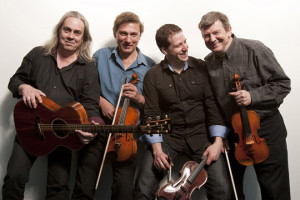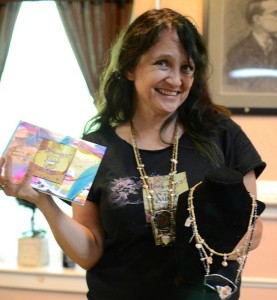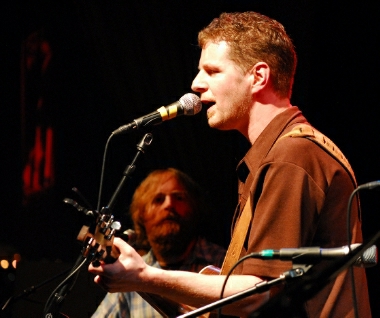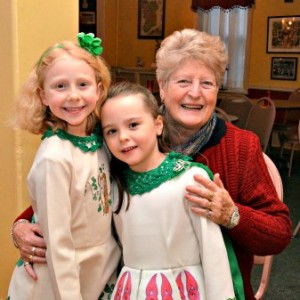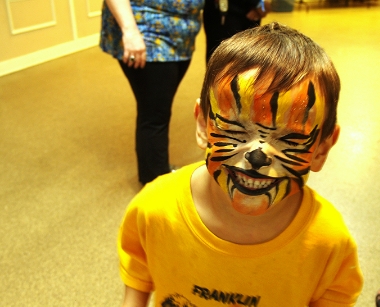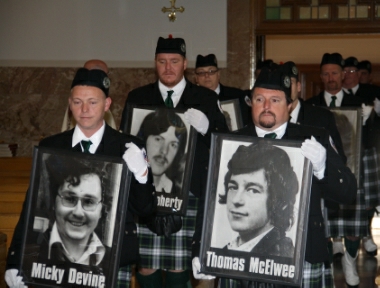
Members of AOH Div. 39 carry photos of the Hunger Strikers into the church.
The Patrick Coughlin Honor Guard of AOH Div. 39 marched into St. Anne’s Church in Philadelphia on Sunday, each carrying a large black and white photo of faces that, for many Irish, have become so familiar they didn’t need to be identified. They were the 1981 hunger strikers, 10 men held in HM Prison Maze who were demanding they be treated as political prisoners of the British government: Bobby Sands, Micky Devine, Francis Hughes, Raymong McCreesh, Patsy O’Hara, Joe McDonnell, Martin Hurson, Kevin Lynch, Kieran Doherty, Thomas McElwee. See more photos by Christopher Conley Sr. here.
Father Ed Brady, pastor of St. Anne’s who serves as chaplain to many Irish organizations in the region, celebrated a Mass in commemoration of their sacrifice. One of the speakers at the Mass was Christopher Conley, Jr., who explained the historical significance of the hunger strike, from its ancient roots in Brehon law (it’s known as the “trocad”), and its link to the protests that came before, from the Mayo land wars to the great Dublin lockout of 1913. Conley shared his speech with us:
The poem “The King’s Threshold” by William Butler Yeats, which describes an ancient bard engaging on a hunger strike against a tyrannical, miserly king who refuses him hospitality, is often used as an introduction to discussion and reflection on hunger striking in Irish Republicanism. It is a fitting place to start, for its feudal setting illustrates how deep-seated the ancient act of hunger striking is in Irish culture.
Dating back to pre-Christian times, by the Middle Ages the hunger strike was enshrined in the Brehon Law codes. Known as the “toscad” the hunger strike was a last ditch method of grievance whereby a person wishing to compel a wrongdoer to justice, oftentimes over an unreasonable debt, would literally starve himself on the wrongdoer’s doorstep. If the wrongdoer allowed the hunger striker to die, it was written in the code that ” He who disregards the faster shall not be dealt with by God nor man … he forfeits his legal rights to anything according to the decision of the Brehon.”
Looking at this historical tradition of the hunger strike that legally enshrined morality over economic greed, we can see how the hunger strike came to be such a compelling and powerful tool in Irish Republicanism. A depraved level of economic oppression meant to exploit and subjugate the native Irish has long been a favorite weapon in the imperial arsenal of the British occupiers. During the genocide falsely called a famine a perverse sense of superiority and entitlement was used to justify the engineered starvation and forced emigration of millions in the name of free trade.
The next generation of Irish people responded to the legacy of genocide through resistance in the form of the land wars in County Mayo, by no coincidence the county most hardest hit by the genocide. This agrarian rent struggle against the gombeen men of British imperial landlords gave birth to a word that has taken on a wider meaning in labor disputes, the “boycott.” But it is important for us here to recognize that in its origin the boycott was a weapon used by the proud people of Ireland to subvert British rule and demonstrate to their occupiers that there was nothing in their whole Imperial economic arsenal that can break the spirit of the Irish people who do not wish to be broken.
With these precedents in mind, when we then look at the events of the great Dublin lockout of 1913 and the forgotten hunger striker James Byrne we can correctly place them in their Irish Republican context. The great Dublin lockout is not just a labor struggle which happened to have some Republicans on the picket line. Rather, the lockout was an anti-imperial Republican action to organize the Irish people through industrial unionism in order to sever the colonial chains of Britain by asserting that the Irish people had ownership of their land and therefore the right to the fruits of all labor produced there.
This was the inspirational message of James Larkin and James Connolly that inspired another James, James Byrne to join the Irish Transport and General Workers Union. A 38-year-old married father of six, James Byrne was the secretary of the Bray and Kingstown trades council and an Irish Transport & General Workers’ Union branch secretary. On October 20, 1913, he was falsely accused of intimidation of a strikebreaking tram driver and imprisoned by the Dublin Metropolitan Police. He was thrown into Mountjoy Prison, in a cold, damp cell. When he was refused bail, he embarked on a hunger and thirst strike. Although the British government gave in to the protest after several days and granted him bail, the weakened physical state brought about by the strike combined in a tragic way with the deplorable environment of his jail cell. James Byrne caught pneumonia and died in a hospital just two weeks after his arrest.
His funeral was held on Nov 3, 1913, before a throng of 3000 people. James Connolly delivered an oration from atop a cab due to the size of the crowd. In his speech Connolly underscores the Republican importance of James Byrne’s sacrifice. He is quoted as telling the mourners that “Their comrade had been murdered as surely as any of the martyrs in the long line list of those who had suffered for the sacred cause of liberty. … [and] If their murdered comrade could send them a message it would be to go on with the fight for the sacred cause of liberty, even if it brought them hunger, misery, eviction and even death itself, as it had done Byrne.”
Although we have focused on James Byrnes’ hunger strike in this 100th year Anniversary of the Dublin lockout, its important to note that highlighting him does not neglect our brave men of ’81. As a matter of fact, through studying James Byrne’s sacrifice, we are actually emphasizing the context of and adding to significance of the sacrifice of the ten brave men.
Just as James Byrnes and James Connolly were radicalized by overbearing poverty in the Dublin area, it should come as no surprise that 46 years after the great Dublin lockout the spirit of Irish Republicanism rose like a phoenix from the working-class nationalist neighborhoods of Derry and Belfast. Once again, Britain was using economics as a means of subjugation and oppression by first imposing an artificial border that created two economically unviable states, and then as a further act of conceit and contempt, in the statelet under their rule, they intentionally marginalized the Irish Nationalist community from prosperity.
Furthermore, it should come as no surprise to us that much like James Byrne, our ten brave men found themselves in cold, damp cells, denied due process of the law or any objective form of justice. We should also take moment to pause and reflect that much like James Byrne most of these ten men were husbands and fathers. And yet these men bravely and selflessly gave their lives, deliberately starving in order to compel Britain to justice, and so became martyrs in the long line list of those who suffered for the sacred cause of Irish liberty. And like the people who crowded the cemetery to hear James Connolly speak, we are all here to acknowledge their sacrifice as heroes in the liberation struggle for Ireland.
In conclusion, I would like to say that when I was first asked to give the reading today, I was nervous. After all, I would be speaking to many people who were alive when history was made, so to speak. However, I think that by asking me to give a reading emphasizes the very reason we gather to honor these brave men, because it was the devotion to the Irish cause from my teachers of the generations before me who inspired me to become involved and to begin teaching my son as well.
The current Haass talks drive home how important it is for Irish America to stay vigilant in regards to the cause of Irish freedom. But more importantly, a piece of history was made in between this Mass and our last memorial. A particularly odious antagonist in the summer of ‘81, Margaret Thatcher, has passed away. Although Margaret Thatcher received a whitewash treatment in a Hollywood movie that completely omitted the hunger strikes, nevertheless even in death she could not escape the shame that the hunger strikers had brought to her doorstep; as a matter of fact, almost every obituary mentioned it.
And there lies the poetic justice. Just like the King in W.B. Yeats poem, Thatcher scoffed at the toscad as an “old and foolish custom,” and yet through a law more ancient than the Brehon our bold men have managed to leave the onus of shame on the doorstep of Thatcher’s grave. I do say that this is poetic justice served at this point; the legacy of Irish freedom remains still an “unfinished song.” But through our continual vigilance and advocacy, we can hope to finally see a rising of the moon that lets us tell our brave men that our day has come.


